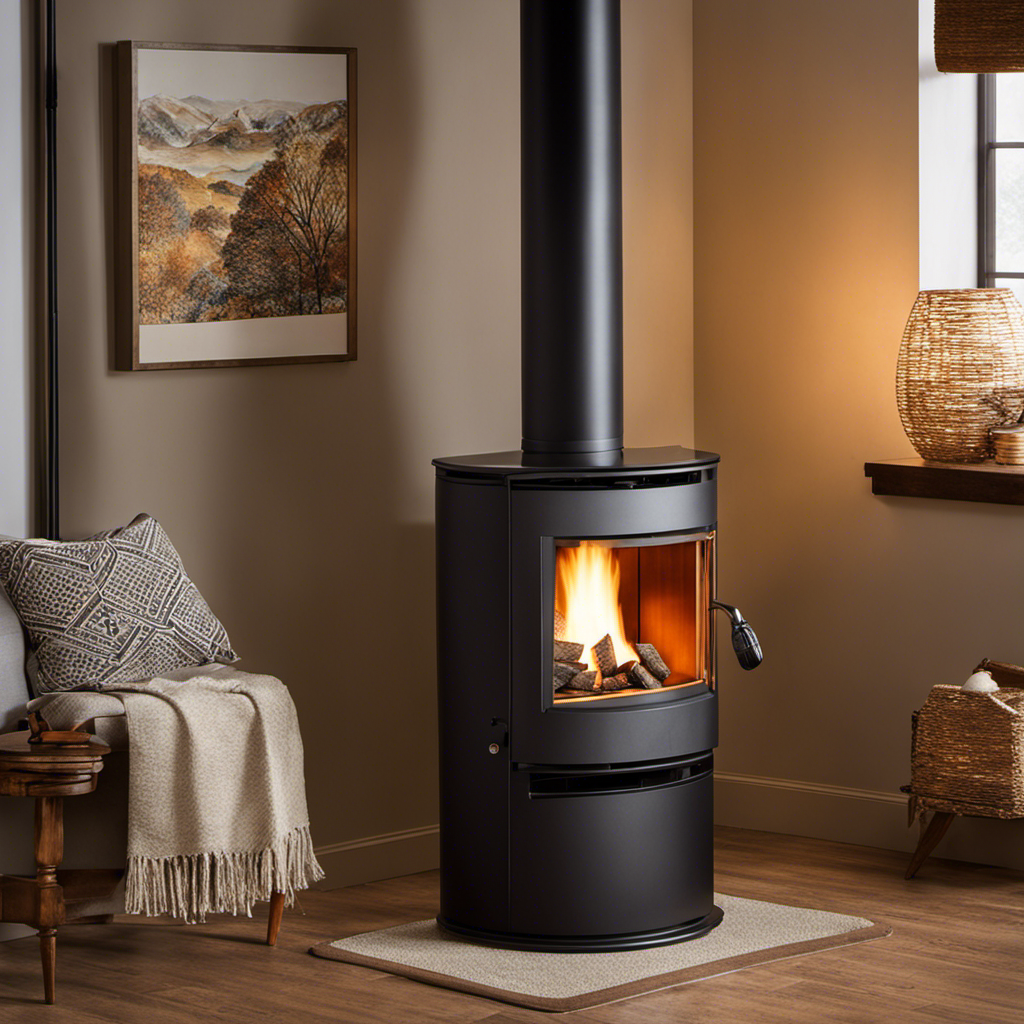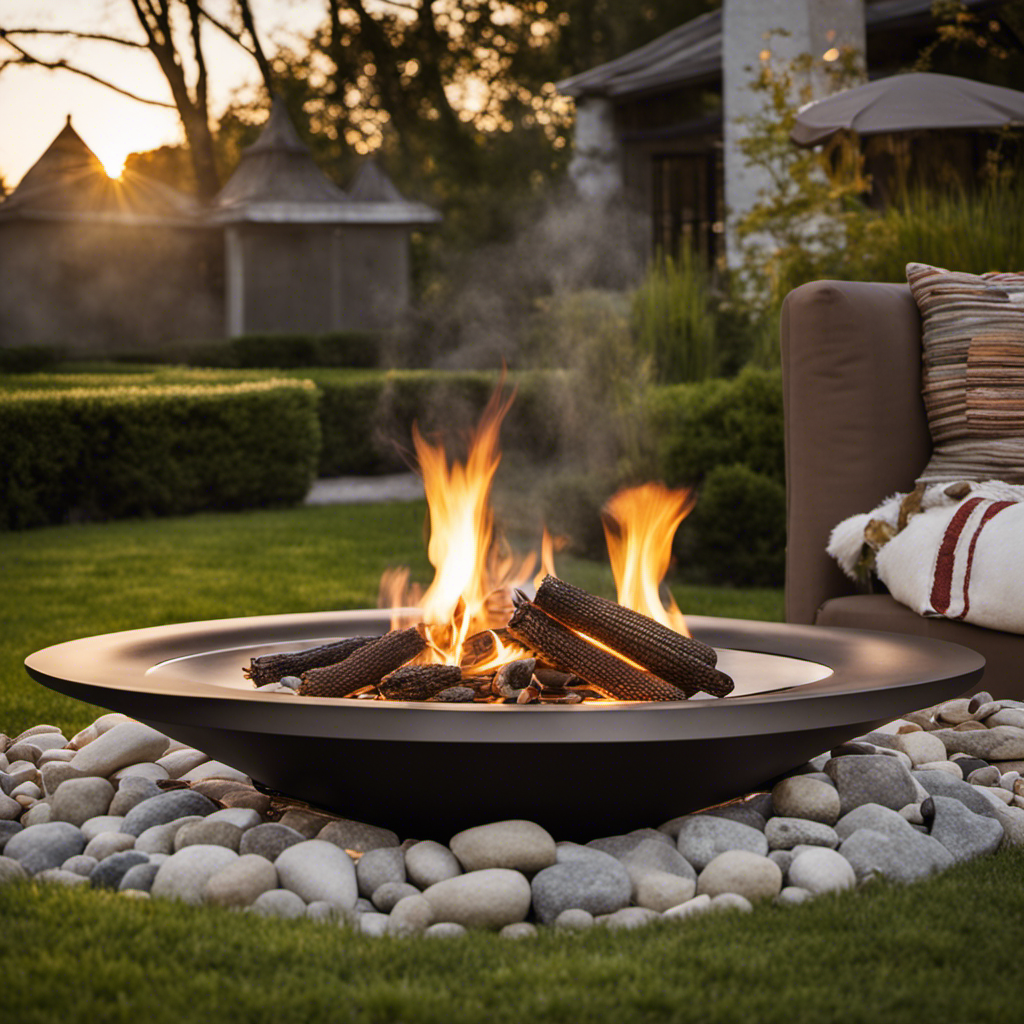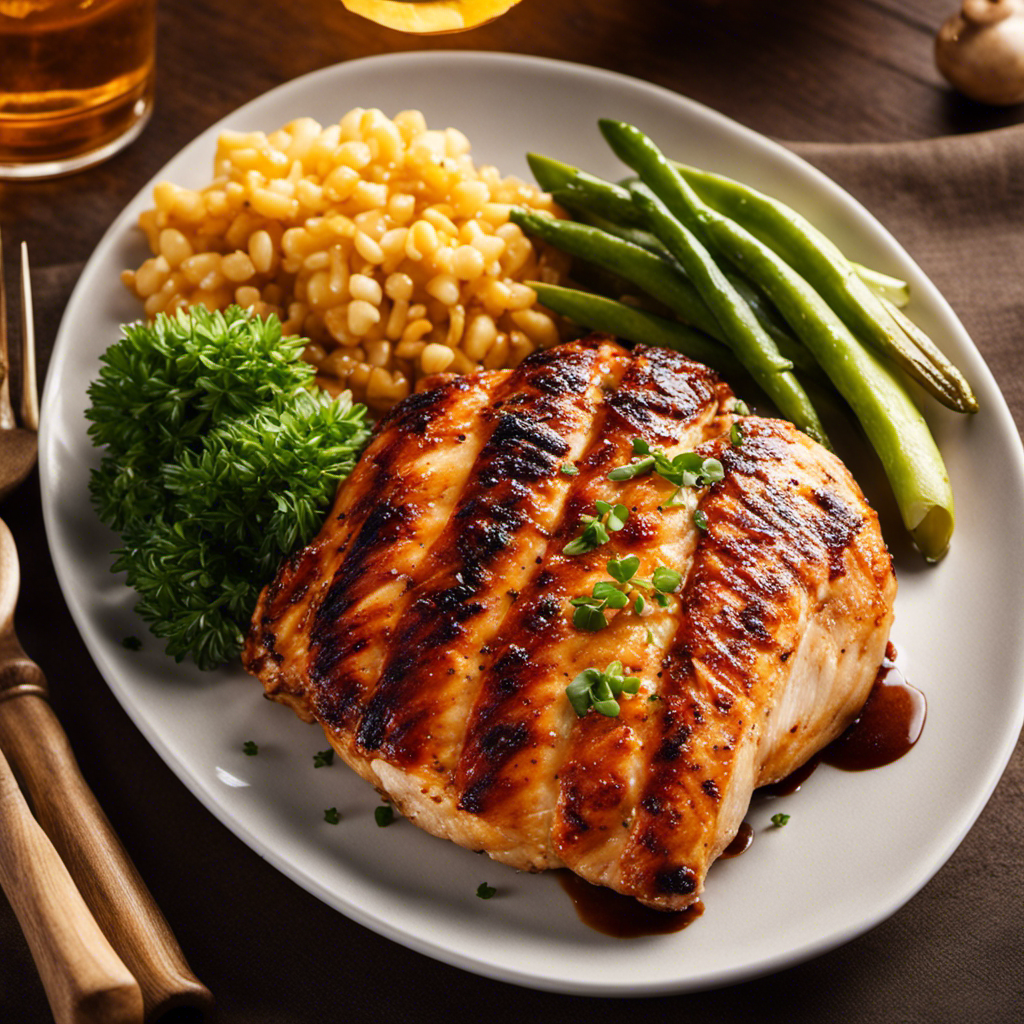Have you ever wondered how a wood pellet operates? Let me provide some insights.
Wood pellets are a fascinating source of energy that have gained popularity in recent years. They are made from compressed sawdust and other wood waste materials, making them a sustainable and renewable fuel option.
In this article, I will walk you through the composition, manufacturing process, and ignition and combustion process of wood pellets. Get ready to delve into the technical details and discover the energy efficiency and environmental benefits of wood pellets.
Key Takeaways
- Wood pellets are made from compressed sawdust and other wood waste materials, undergoing drying and grinding to ensure uniform consistency.
- The ignition and combustion process of wood pellets involves decomposition, release of volatile gases, and sustained flame with the presence of fuel.
- Wood pellets have a lower carbon footprint compared to fossil fuels, contribute to sustainable forestry practices, and reduce air pollution.
- Proper storage, handling, maintenance, and troubleshooting techniques are crucial for maximizing efficiency and usability of wood pellets.
The Basics of Wood Pellets
Wood pellets are made from compressed sawdust and other wood waste materials. Wood pellet production involves grinding and drying the raw materials to reduce their moisture content. The dried sawdust is then compressed under high pressure, using a pellet mill, to form small cylindrical pellets. The compression process increases the density of the pellets, making them more durable and energy-dense.
To ensure wood pellet quality, the raw materials must be carefully selected and processed. High-quality wood pellets should have a low moisture content, typically below 10%, and a high energy content. They should also have a uniform size and shape to ensure efficient combustion. The composition and manufacturing process of wood pellets play a crucial role in their overall performance and efficiency.
Moving on to the next section, let’s delve into the detailed composition and manufacturing process of wood pellets without delay.
Composition and Manufacturing Process
The composition and manufacturing process of a wood pellet involves compressing sawdust and other wood waste into a small, dense form. This process utilizes various manufacturing techniques to ensure the pellets are of high quality and efficiency.
Here are three key aspects of the pellet composition and manufacturing process:
-
Raw materials selection: The process begins by carefully selecting the appropriate mix of wood waste, such as sawdust, wood chips, and shavings. The type and quality of these materials directly impact the final product’s performance.
-
Drying and grinding: After selection, the wood waste undergoes a thorough drying process to reduce moisture content. Subsequently, the dried material is finely ground into a uniform consistency, ensuring optimal compression and combustion.
-
Compression and binding: The ground wood waste is then fed into a pellet mill, where it is compressed under high pressure and heat. This process causes lignin, a natural binder in wood fibers, to soften and act as a glue, binding the compressed material together.
The manufacturing techniques employed in pellet production result in a uniform and dense product, ready for the ignition and combustion process.
Ignition and Combustion Process
Once ignited, wood pellets release a steady and consistent heat, making them a reliable source of energy for heating purposes.
The ignition temperature of wood pellets typically ranges from 350 to 500 degrees Fahrenheit. When exposed to this temperature, the pellets start to decompose and release volatile gases. These gases mix with oxygen in the air and ignite, creating a flame that sustains itself as long as there is fuel.
The combustion efficiency of wood pellets refers to how effectively they convert energy from burning into heat. It is influenced by factors such as pellet moisture content, oxygen supply, and design of the heating appliance. A high combustion efficiency ensures that more heat is produced from the same amount of fuel, reducing waste and increasing the overall energy efficiency.
Transitioning into the subsequent section about the energy efficiency of wood pellets, it is important to analyze how different factors impact the overall efficiency of wood pellet heating systems.
Energy Efficiency of Wood Pellets
When discussing the environmental impact of wood pellets, it’s important to consider factors such as the source of the wood, transportation emissions, and the carbon footprint associated with production.
Additionally, the cost-effectiveness of wood pellets can depend on various factors. These include the availability and price of alternative energy sources, the efficiency of the pellet stove, and the cost of purchasing and maintaining the equipment.
Environmental Impact of Wood Pellets
You might be wondering about the environmental impact of wood pellets.
When it comes to carbon footprint, wood pellets have a lower emission compared to fossil fuels. This is because the carbon released during combustion is offset by the carbon absorbed by trees during their growth.
However, there are deforestation concerns associated with wood pellets. The demand for wood pellets has led to an increase in logging activities, which can result in habitat destruction and loss of biodiversity. To mitigate these concerns, sustainable forestry practices and certification programs have been implemented to ensure that the wood used for pellets comes from responsibly managed forests.
Transitioning to the cost-effectiveness of wood pellets, it is important to consider the long-term savings in energy costs and the potential for government incentives to offset the initial investment.
Cost-Effectiveness of Wood Pellets
To determine the cost-effectiveness of wood pellets, consider the long-term savings in energy costs and the potential for government incentives to offset the initial investment.
Wood pellets are a highly efficient and renewable source of energy that can significantly reduce heating costs over time. The cost effectiveness of wood pellets lies in their ability to provide consistent and efficient heat while also being more affordable than traditional fuel sources.
In addition to the long-term savings, there are often government incentives available that can further reduce the cost of transitioning to wood pellets. These incentives can include tax credits, grants, or rebates that can help offset the initial investment.
By taking advantage of these incentives and considering the long-term savings, wood pellets can be a cost-effective choice for heating your home or business.
Moving forward, it’s important to also consider the environmental benefits of wood pellets.
Environmental Benefits of Wood Pellets
Using wood pellets for heating is a great way to reduce your carbon footprint and contribute to a cleaner environment. Wood pellets are a form of renewable energy made from compressed wood waste, such as sawdust or wood shavings. When burned, they release carbon dioxide, but the amount is equal to the carbon dioxide absorbed by the trees during their growth, making them carbon neutral. This means that wood pellets do not contribute to the greenhouse effect and climate change.
Additionally, wood pellets produce fewer emissions compared to fossil fuels like coal or oil, reducing air pollution. Furthermore, the production of wood pellets utilizes wood waste that would otherwise end up in landfills, promoting sustainable forestry practices.
Transitioning to wood pellets as a heating source is a practical and eco-friendly choice for a greener future.
Now, let’s delve into the storage and handling of wood pellets.
Storage and Handling of Wood Pellets
In order to make the most out of wood pellets, proper storage and handling techniques are crucial.
The storage of wood pellets involves keeping them in a dry, well-ventilated area away from moisture and direct sunlight. This helps to maintain their quality and prevent deterioration.
Additionally, it is important to handle wood pellets carefully to avoid breakage and dust formation. When transporting wood pellets, various methods can be used such as bulk trucks, bags, or containers. Each method has its own advantages and considerations, including cost, convenience, and capacity.
For instance, bulk trucks are ideal for large-scale deliveries, while bags are more suitable for smaller quantities. By employing appropriate storage techniques and transportation methods, the efficiency and usability of wood pellets can be maximized.
Moving on to the next section about maintenance and cleaning of wood pellet appliances…
Maintenance and Cleaning of Wood Pellet Appliances
Proper maintenance and cleaning of wood pellet appliances is essential for ensuring their longevity and efficiency. To keep your wood pellet appliance in top condition, follow these maintenance tips.
-
Regularly inspect the hopper and remove any debris or foreign objects that may have accumulated. This will prevent clogs and ensure proper pellet flow.
-
Clean the burn pot and heat exchanger to remove ash buildup, which can hinder combustion and reduce efficiency.
-
Additionally, clean the exhaust vent and flue pipe to prevent blockages and ensure proper ventilation.
If you encounter any issues with your wood pellet appliance, such as poor heat output or ignition problems, try these troubleshooting techniques.
- Check the fuel supply, ensure proper pellet quality, and inspect the ignition system for any faults.
By following these maintenance tips and troubleshooting techniques, you can keep your wood pellet appliance running smoothly and efficiently.
Now, let’s explore the common uses and applications of wood pellets.
Common Uses and Applications of Wood Pellets
When it comes to residential heating options, one of the key factors to consider is whether the energy source is renewable or not. Renewable energy sources are becoming increasingly popular due to their sustainability and environmental benefits.
In this discussion, we will explore various residential heating options that utilize renewable energy sources, such as solar, geothermal, and biomass, and delve into their technical aspects and benefits.
Residential Heating Options
For residential heating options, you should consider using a wood pellet stove. Wood pellets are a renewable energy source that offer efficient and cost-effective heating solutions for homes. Made from compressed sawdust and other wood waste materials, wood pellets are a sustainable alternative to traditional fossil fuels.
They are clean-burning, producing minimal emissions and reducing the carbon footprint. Wood pellet stoves are designed to burn these pellets efficiently, providing a steady and consistent source of heat. They are easy to use and maintain, with automatic ignition and temperature control features.
With a wood pellet stove, you can enjoy a cozy and warm home while contributing to a greener environment.
Transitioning from residential heating options to renewable energy sources, let’s explore the benefits of wood pellets in greater detail.
Renewable Energy Source
Using wood pellets as a renewable energy source offers a cost-effective and eco-friendly solution for residential heating. Wood pellet production involves the compression of sawdust and other wood waste into small cylindrical pellets. These pellets are made without any additives or binders, ensuring a clean and sustainable fuel source.
The process begins with the collection and storage of raw materials, which are then dried to remove moisture content. The dried wood waste is then ground into a fine powder and passed through a pellet mill, where heat and pressure are applied to compress the material into pellets. Finally, the pellets are cooled, screened, and packaged for distribution.
Wood pellets are a renewable energy source because they are made from sustainable wood waste that would otherwise be discarded. They provide a reliable and efficient heating option for residential properties.
Can Wood Pellet Mills Help in Understanding How Wood Pellets Work?
Wood pellet mills operation can offer insight into the process of how wood pellets work. By understanding the mechanics of how these mills produce pellets, one can gain a better understanding of the properties of wood pellets and how they can be utilized for various applications.
What is the Process of Creating Wood Pellets and How Do They Function in Machinery?
Wood pellet mills operation explained is a detailed process of creating wood pellets. The raw materials are ground into sawdust, dried, and then compressed using high pressure. These pellets are commonly used as a renewable fuel source in various machinery, such as pellet stoves and boilers, due to their high energy content and clean-burning properties.
Frequently Asked Questions
Can Wood Pellets Be Used in All Types of Pellet Stoves and Boilers?
Yes, wood pellets can be used in most pellet stoves and boilers. They offer several advantages, such as higher energy density and lower emissions compared to other fuels. However, it is important to check the specific requirements of your appliance.
How Long Do Wood Pellets Typically Last When Used in a Heating Appliance?
Wood pellets typically last for hours when used in a heating appliance due to their high energy density. They burn efficiently, releasing a consistent amount of heat. They’re a great fuel source for long-lasting warmth.
Are Wood Pellets More Expensive Than Traditional Heating Fuels Like Oil or Gas?
Wood pellet pricing comparison: Wood pellets are generally more cost-effective than traditional heating fuels like oil or gas. Additionally, they have a lower environmental impact, as they are made from a renewable source and produce less greenhouse gas emissions.
Can Wood Pellets Be Used as a Primary Heat Source in a Residential Setting?
Certainly, wood pellets can be used as a primary heat source in residential settings. Their environmental impact is lower compared to traditional heating fuels, and their efficiency is comparable or even better.
Are There Any Safety Concerns Associated With Using Wood Pellets for Heating Purposes?
There are safety precautions to consider when using wood pellets for heating, such as proper storage and handling to prevent fires. Regular maintenance is also necessary to ensure the safe and efficient operation of the pellet stove.
Conclusion
In conclusion, wood pellets are a highly efficient and environmentally friendly source of energy. They are made from compressed sawdust and wood waste, which makes them a renewable and sustainable fuel option.
Wood pellets have a high energy density, allowing for a longer burn time and increased heat output. One interesting statistic is that wood pellet stoves are 80% more efficient than traditional fireplaces, resulting in significant cost savings and reduced carbon emissions.
Overall, wood pellets are a smart choice for heating homes and reducing our carbon footprint.
Growing up surrounded by the vast beauty of nature, Sierra was always drawn to the call of the wild. While others sought the comfort of the familiar, she ventured out, embracing the unpredictable and finding stories in the heartbeat of nature.
At the epicenter of every remarkable venture lies a dynamic team—a fusion of diverse talents, visions, and passions. The essence of Best Small Wood Stoves is crafted and refined by such a trio: Sierra, Logan, and Terra. Their collective expertise has transformed the platform into a leading authority on small wood stoves, radiating warmth and knowledge in equal measure.











